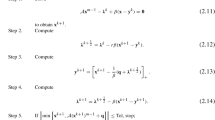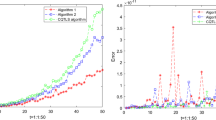Abstract
The largest C-eigenvalue of piezoelectric tensors determines the highest piezoelectric coupling constant, which reflects the coupling between the elastic and dielectric properties of crystal. Here, a projection method based on discrete normalized dynamical system (PDND) is established for computing the largest C-eigenvalue. Theoretical analysis of the convergence for PDND algorithm is given. In numerical experiments, the longitudinal piezoelectric modulus and the unit uniaxial direction that the extreme piezoelectric effect along took place of different piezoelectric materials are given to display the physical meaning of the C-eigenvalues and eigenvectors. Furthermore, the largest C-eigenvalue and all the corresponding eigenvectors can be obtained, which is the advantage of the proposed method.







Similar content being viewed by others
Data Availability
All data generated or analyzed during this study are included in this article.
References
Benson, A.R., Gleich, D.F.: Computing tensor Z-eigenvectors with dynamical systems. SIAM J. Matrix Anal. Appl. 40(4), 1311–1324 (2019)
Che, H., Chen, H., Wang, Y.: C-eigenvalue inclusion theorems for piezoelectric-type tensors. Appl. Math. Lett. 89, 41–49 (2019)
Che, H., Chen, H., Wang, Y.: On the M-eigenvalue estimation of fourth order partially symmetric tensors. J. Ind. Manag. Optim. 16(1), 309–324 (2020)
Chen, L., Han, L., Zhou, L.: Computing tensor eigenvalues via homotopy methods. SIAM J. Matrix Anal. Appl. 37(1), 290–319 (2016)
Chen, Y., Jákli, A., Qi, L.: The C-eigenvalue of third order tensors and its application in crystals. J. Ind. Manag. Optim. 19(1), 265–281 (2023)
Cui, L., Hu, Q., Chen, Y., Song, Y.: A Rayleigh quotient-gradient neural network method for computing \({\cal{Z} }\)-eigenpairs of general tensors. Numer. Linear Algebra Appl. 29(3), e2420 (2022)
Curie, J., Curie, P.: Développement par compression de l’électricité polaire dans les cristaux hémièdres à faces inclinées. Bull. Minér. 3(4), 90–93 (1880)
Curie, J., Curie, P.: Contractions et dilatations produites par des tensions électriques dans les cristaux hémièdres à faces inclinées. C. R. 93, 1137–1140 (1881). (in French)
de Jong, M., Chen, W., Geerlings, H., Asta, M., Persson, K.A.: A database to enable discovery and design of piezoelectric materials. Sci. Data 2(1), 1–13 (2015)
De Lathauwer, L., De Moor, B., Vandewalle, J.: A multilinear singular value decomposition. SIAM J. Matrix Anal. Appl. 21, 1253–1278 (2000)
Gaeta, G., Virga, E.G.: Octupolar order in three dimensions. Eur. Phys. J. E 39(11), 113 (2016)
Gonze, X.: Adiabatic density-functional perturbation theory. Phys. Rev. A 52(2), 1096 (1995)
Guo, D., Yan, L., Nie, Z.: Design, analysis, and representation of novel five-step DTZD algorithm for time-varying nonlinear optimization. IEEE Trans. Neural Netw. Learn. Syst. 29(9), 4248–4260 (2017)
Guo, C., Lin, W., Liu, C.: A modified Newton iteration for finding nonnegative Z-eigenpairs of a nonnegative tensor. Numer. Algorithms 80, 595–616 (2019)
Han, L.: An unconstrained optimization approach for finding real eigenvalues of even order symmetric tensors. Numer. Algebra Control Optim. 3, 583–599 (2013)
Hao, L., Cui, F., Dai, H.: A sequential subspace projection method for extreme Z-eigenvalues of supersymmetric tensors. Numer. Linear Algebra Appl. 22(2), 283–298 (2015)
Haussüuhl, S.: Physical Properties of Crystals: An Introduction. Wiley, Weinheim (2007)
He, J., Liu, Y., Xu, G.: An S-type inclusion set for C-eigenvalues of a piezoelectric-type tensor. Appl. Math. Lett. 121, 107448 (2021)
Hu, S., Huang, Z., Qi, L.: Finding the extreme Z-eigenvalues of tensors via a sequential semidefinite programming method. Numer. Linear Algebra Appl. 20(6), 972–984 (2013)
Jerphagnon, J.: Invariants of the third-rank Cartesian tensor: optical nonlinear susceptibilities. Phys. Rev. B 2(4), 1091 (1970)
Kholkin, A.L., Pertsev, N.A., Goltsev, A.V.: Piezolelectricity and crystal symmetry. In: Safari, A., Akdog̃an, E.K. (eds.) Piezoelectric and Acoustic Materials, pp. 17–38. Springer, New York (2008)
Kolda, T.G., Mayo, J.R.: Shifted power method for computing tensor eigenpairs. SIAM J. Matrix Anal. Appl. 32(4), 1095–1124 (2011)
Kolda, T.G., Mayo, J.R.: An adaptive shifted power method for computing generalized tensor eigenpairs. SIAM J. Matrix Anal. Appl. 35(4), 1563–1581 (2014)
Kulagin, I.A., Ganeev, R.A., Tugushev, R., Ryasnyansky, A.I., Usmanov, T.: Components of the third-order nonlinear susceptibility tensors in KDP, DKDP and LiNbO3 nonlinear optical crystals. Quantum Electron. 34(7), 657 (2004)
Kuo, Y., Lin, W., Liu, C.: Continuation methods for computing Z-/H-eigenpairs of nonnegative tensors. J. Comput. Appl. Math. 340, 71–88 (2018)
Li, C., Liu, Y., Li, Y.: C-eigenvalues intervals for piezoelectric-type tensors. Appl. Math. Comput. 358, 244–250 (2019)
Liang, C., Yang, Y.: Shifted eigenvalue decomposition method for computing C-eigenvalues of a piezoelectric-type tensor. Comput. Appl. Math. 40(7), 1–22 (2021)
Lim, L.: Singular values and eigenvalues of tensors: a variational approach. In: CAMSAP05: Proceeding of IEEE International Workshop on Computational Advances in Multi-Sensor Adaptive Processing 1, pp. 129–132 (2005)
Lippmann, G.: Principe de la conservation de l’électricité, ou second principe de la théorie des phénomènes électriques. Ann. Chim. Phys. 10(1), 381–394 (1881)
Lovett, D.: Tensor Properties of Crystals, 2nd edn. Institute of Physics Publishing, Bristol (1989)
Nye, J.F.: Physical Properties of Crystals: Their Representation by Tensors and Matrices. Oxford University Press, Oxford (1985)
Ouyang, J., Ramesh, R., Roytburd, A.L.: Intrinsic effective piezoelectric coefficient e 31, f for ferroelectric thin films. Appl. Phys. Lett. 86(15), 152901 (2005)
Qi, L.: Eigenvalues of a real supersymmetric tensor. J. Symb. Comput. 6, 1302–1324 (2005)
Sang, C.: A new Brauer-type Z-eigenvalue inclusion set for tensors. Numer. Algorithms 80(3), 781–794 (2019)
Wang, W., Chen, H., Wang, Y., Zhou, G.: A proximal alternating minimization algorithm for the largest C-eigenvalue of piezoelectric-type tensors. J. Glob. Optim. 1–18 (2022)
Wang, G., Zhou, G., Caccetta, L.: Z-eigenvalue inclusion theorems for tensors. Discrete Contin. Dyn. Syst.-Ser. B 22, 187–197 (2017)
Wang, X., Che, M., Wei, Y.: Neural network approach for solving nonsingular multi-linear tensor systems. J. Comput. Appl. Math. 368, 112569 (2020)
Warner, A.W., Onoe, M., Coquin, G.A.: Determination of elastic and piezoelectric constants for crystals in class (3m). J. Acoust. Soc. Am. 42(6), 1223–1231 (1967)
Wilkinson, J.H.: The Algebraic Eigenvalue Problem. Clarendon, Oxford (1965)
Yang, Y., Liang, C.: Computing the largest C-eigenvalue of a tensor using convex relaxation. J. Optim. Theory Appl. 192(2), 648–677 (2022)
Zhao, J., Luo, J.: Properties and calculation for C-eigenvalues of a piezoelectric-type tensor. J. Ind. Manag. Optim. (2021). https://doi.org/10.3934/jimo.2021162
Zhao, R., Zheng, B., Liang, M., Xu, Y.: A locally and cubically convergent algorithm for computing \({\cal{Z} }\)-eigenpairs of symmetric tensors. Numer. Linear Algebra Appl. 27(3), e2284 (2021)
Acknowledgements
The authors are grateful to the handling editor and anonymous referees for useful comments and suggestions that contributed to improving the quality of the manuscript.
Funding
This research is supported in part by National Natural Science Foundations of China (No.12171087), Shanghai Municipal Science and Technology Commission under Grant 23WZ2501400 (China), Foundation of Henan Educational Committee (No.21A110013), Foundation of Henan Normal University (No.2021PL03), Xinxiang aviation industry (Group) Co., Ltd (No. 5201019160013).
Author information
Authors and Affiliations
Corresponding author
Ethics declarations
Conflict of interest
The authors declare that they have no conflict of interest.
Additional information
Communicated by Liqun Qi.
Publisher's Note
Springer Nature remains neutral with regard to jurisdictional claims in published maps and institutional affiliations.
Rights and permissions
Springer Nature or its licensor (e.g. a society or other partner) holds exclusive rights to this article under a publishing agreement with the author(s) or other rightsholder(s); author self-archiving of the accepted manuscript version of this article is solely governed by the terms of such publishing agreement and applicable law.
About this article
Cite this article
Cui, LB., Yao, JL. & Yuan, JY. A Projection Method Based on Discrete Normalized Dynamical System for Computing C-eigenpairs. J Optim Theory Appl 200, 768–793 (2024). https://doi.org/10.1007/s10957-023-02341-x
Received:
Accepted:
Published:
Issue Date:
DOI: https://doi.org/10.1007/s10957-023-02341-x




